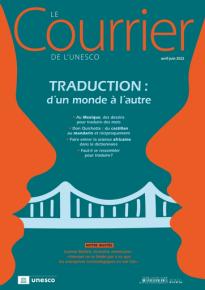فكرة
من المستفيد من استغلال التراث "العرقي"؟

تشهد الزخارف المُسمّاة بـ"العرقية" رواجا كبيرا بعد أن وقع الاستيلاء عليها من قبل المصمّمين والعلامات التّجارية الكبرى حيث أصبحت تزيّن سلع الموضة التي تباع في جميع أنحاء العالم دون استشارة مسبقة، في أغلب الأحيان، للجماعات صاحبة هذه الزّخارف. وتطالب عالمة الأنثروبولوجيا المكسيكية، مارتا توروك، المتخصصة في النسيج التقليدي، بمزيد الاهتمام بحقوق جماعات السكّان الأصليين وأخذ مصالحهم بعين الاعتبار.
مارتا توروك
عالمة الأنثروبولوجيا المكسيكية وأمينة مجموعة روث د. ليتشوجا للفن الشعبي في متحف فرانز ماير للفنون الزخرفية بمكسيكو. وهي أيضا مؤلفة لعديد الكتب والمقالات حول الحرف اليدوية.
تعود القصّة إلى سنة 2015 حين فُوجئت المغنية الشهيرة سوزانا هارب، والعضوة في مجلس الشيوخ المكسيكي، باكتشافها في متجر بمركز تجاري بلاس فيغاس (الولايات المتحدة)، صدريّة مطرزة، ذات أكمام طويلة، شبيهة بتلك التي تصنعها جماعة ميكس المحلية في سانتا ماريا تلاهويتولتيباك من ولاية أواكساكا، جنوب المكسيك.
كانت القطعة، التي تحمل ختم مصمّمة فرنسية، مصنوعة في الهند باستخدام نموذج خياطة طبق الأصل، ونفس تقنيات التّطريز والألوان والرسم مقارنة بالأصل، مع فارق وحيد يتمثّل في سعر بيعها البالغ 290 دولار والحال أنّ معدّل ثمنها داخل الجماعة المحلية في حدود 35 دولارا.
وللتّعبير عن غضبها، نشرت سوزانا هارب في شبكات التواصل الاجتماعي صورة للصّدرية التي لا يُشير أي جزء من البطاقة المُرفقة بها إلى أصلها، وتقدّمت بشكوى قضائية من أجل الانتحال والاستيلاء الثقافي.
في الأشهر الموالية، أدلت مسؤولات عن الجماعة المحلية بعديد التّصريحات في مدينتي أواكساكا ومكسيكو، مرفقات بممثلات عن المطرّزات. وأصررن على أنّ المصممة لم تأت لمقابلتهنّ، مما حرمهنّ من فرصة ليشرحن لها دلالات الأشكال المطرزة على الصدريّة ومغزاها، وأضفن أن هذا الزّيّ التقليدي الموشّح بزخارف قديمة لم يكن معروضا للبيع. كما أكّدن على أنّ الأمر لا يتمثّل في منح ترخيص أو الحصول على حقوق الاستنساخ أو أيّ نوع من الإتاوات.
مشهد مقدّس
أمّا الأكثر إثارة للدهشة، فهو أنّ شركة ملابس فرنسية صاحبة علامة أخرى، قدّمت، في نفس الوقت، شكوى ضد ذات المصممة في المحاكم الفرنسية بتهمة "سرقة زخرفة"، مدّعية أسبقية استخدامها لتلك الزّخرفة. ولكسب القضية أمام العدالة، اعترفت المصمّمة الفرنسية بأنها تحوّلت إلى الجماعة المحلية لاقتناء الثوب مباشرة من الأهالي.
كما قدّمت أدلة تثبت أن تلك الرّحلة كانت سابقة للتاريخ الذي زعمته صاحبة الشكوى، وخلُصت إلى أنها "استعارت" من جماعة سانتا ماريا تلاهويتولتيبيك المحلية نموذج الصدرية وتطريزاتها، مُعترفة بذلك بأنها ليست مالكة النموذج. في الوقت نفسه، وبطلب من مجلس الشيوخ المكسيكي، أعلن المعهد المكسيكي للملكية الصناعية أنه ليس هناك انتحال باعتبار أن "المُنْتَج" لم يكن حاصلا على براءة اختراع.
ٍوأخيرا، يجب توضيح أن النص الذي يظهر على البطاقة الملصقة على الثوب تشير إلى أن الصدرية "مصنوعة من نسيج قطني خام، ومطرزة بعناية بخيط أسود وأحمر بنفسجي غامق لتشكيل نقيشة زهرية رائعة". غير أن الزخارف المستنسخة من سانتا ماريا تلاهويتولتيبيك، والمسمّاة اكزامنيكسوي بلغة الميكس، تمثل، في الحقيقة، مشهدا طبيعيًا مقدسًا مكوّنا من زخارف ترمز إلى الشمس، وإلى نبتة الأغاف (الصبّار)، وإلى الأرض، والطريق، والجبل، والقربان، والماء والزّهرة.
إن ما تطالب به الجماعة المحلية في قضية الحال يتمثّل، بكل بساطة، في احترام إرادتها. فهي ترفض السّماح بإخراج الصّدرية من سياقها وتحويلها إلى مجرّد سلعة في السّوق العالميّة وإلى موضة زائلة. وطالما ظلّ الإنتاج والفوائد الاقتصادية تحت رقابتها ومُستوفية للمعايير التي تضعها بنفسها، فهي لا ترى أي عائق أمام الحرفيّين لإنتاج الصّدرية وملابس أخرى وبيعها سواء لدى الجماعة المحلّية أو خارجها.
وعمليا، فقد ارتفعت مبيعات الاكزامْنيكْسوي نتيجة هذه الحملة الإعلامية، وهو ما أكدته عاملات النسيج والتطريز بمناسبة اللقاء الأول الأمريكي اللاتيني للدفاع عن التراث الثقافي، وعن خبرات القدامى، والملكية الفكرية الجماعية وأراضي الشعوب الأصلية، المنعقد في سبتمبر 2018 بسان كريستوبال دي لاس كاساس من ولاية تشياباس بالمكسيك، حيث صرّحن بأنّ: "الهدف ليس خصحصة مهاراتنا وخبراتنا أو أن تكون مسجّلة؛ بل إن إبداعاتنا وتراثنا الثقافي جزء من حياة مناطقنا."
شكاوى من أجل الانتحال
تعتبر قضية الصّدرية المطرّزة، التّابعة لجماعة سانتا ماريا تلاهويتولتيباك المحلية، رمزا للجدل القائم حول الملكية الفكرية. فالشعوب والجماعات الأصلية وحرفيّوها أصبحوا يضعون موضع التّساؤل، أكثر من أيّ وقت مضى، ما يعتبرونه استخداما مبالغا فيه لعناصرهم الثقافية من قبل أطراف خارجية دون استشارة أو إذن مسبق. والنتيجة المنطقية هي تضاعف الشكاوى ضد الاستيلاء الثقافي والانتحال والسرقة.
لقد سرّعت العولمة والتكنولوجيات الحديثة والتنقل الجغرافي في نشر المعلومة، وأُدرج التنوّع الثقافي في مجال الرؤية على الساحة العالمية على نحو غير مسبوق. وقد كان لذلك تداعيات مُضاعَفة ومتضاربة. فمن جهة أولى، وأمام الثّغرات الموجودة في آليات حماية الحقوق الثقافية الجماعية، أتيح للجهات الفاعلة من خارج الجماعات المحلية النّفاذ بسهولة إلى الزّخارف والأشكال التراثية واستغلالها، معبّرين، في أغلب الحالات، على موقف يمكن توصيفه بالاستعماري الجديد. ومن ناحية أخرى، سمحت تلك الظواهر بأن تكون هذه الشعوب والمساندين لها على دراية أفضل بما يحدث وأن يُندّدوا بالانتهاكات بسرعة أكبر.
هكذا أبلغت المنظمة غير الحكومية إينباكتو Impacto، التي تناضل من أجل حقوق الشعوب الأصلية وتنميتها، فيما بين 2012 و2019، عن 39 حالة انتحال على الأقل، مدانة فيها ما لا يقل عن 23 علامة تجارية للملابس من جميع أنحاء العالم. وهي ممارسات كانت محل استنكار منتظم في وسائل الإعلام. ومع ذلك، تتواصل الانتهاكات التي نادرا ما تتمّ معاقبتها. وبالتالي، لم يعد للمجتمعات المستهدفة سوى أن تعاين الوضع، وهي تقف موقف العجز التام أمام شركات محلية، وصناعة، وعلامات تجارية عالمية كبرى، تتاجر بموضة الأزياء المصنوعة من أقمشة "عرقية"، مستغلّة، بكل سهولة، عدم وجود مالك واضح وحماية قانونية. والأمثلة على ذلك ما فتئت تتكاثر دون اكتراث من أي جهة كانت، الأمر الذي يُعمّق من مشاعر الظلم والغضب والسّلب.
ويعود جزء من المشكل إلى قوانين الملكية الفكرية والصناعية الصادرة عن المنظمة العالمية للملكية الفكرية والمتعارضة تماما، من حيث فلسفتها ورؤيتها للعالم، مع مطالب الشعوب الأصلية المتضرّرة والتي تحمل مفاهيم للملكية تقوم على رؤى مغايرة، وتعيش تراثها بطرق مختلفة.
في هذا السّياق، يُعدّ الإصلاح الأخير للقانون الفيدرالي المكسيكي حول حقوق التأليف خطوة في الاتجاه الصحيح. فالأحكام الجديدة، التي دخلت حيز التنفيذ في يناير 2020، تنص، فعليا، على سحب الأعمال الفنية الشعبية والحرفية من مجال الملك العام وإلحاقها بالأعمال الأدبية أو الفنية من حيث حمايتها واحترامها.
إضافة إلى ذلك، سيُصبح من الضّروري، من هنا فصاعدا، طلب ترخيص في استغلال الأعمال الفنية التقليدية، وتسويقها، وتصنيعها، من الجماعات المالكة لها. ومن جهة أخرى، تجري، حاليا، مناقشات حول مشروع قانون للحفاظ على هذه الممتلكات يعاقب الاستخدام غير المرخّص فيه (الانتحال) للعناصر المتصلة بثقافة الشعوب والمجتمعات وبهويتها. وهذا القانون من شأنه إرساء منظومة حماية لهذه العناصر، والدفاع عنها، وتعريفها، وتوثيقها، والبحث في شأنها، وتطويرها، ودعمها، ونقلها عبر الأجيال، وإحيائها على مستوى الفدراليات والولايات والبلديات.
تلك هي الخطوة الأولى والتي تبقى هامّة على الطّريق الطّويل الذي يُؤدّي إلى مراعاةٍ أفضل لحقوق مجتمعات السكان الأصليين ومصالحها.
مطالعات ذات صلة
حول اتفاقية اليونسكو بشأن حماية وتطوير تنوع التعبيرات الثقافية (2005)
أمير التطريز اللاوسي يدافع عن فن الحياة، رسالة اليونسكو، يوليو -أغسطس 2001
التراث غير المادي، رسالة اليونسكو، مايو 2006
اشترك في رسالة اليونسكو لمتابعة الأحداث. الاشتراك في النسخة الرقمية مجاني 100%.
تابع رسالة اليونسكو على تويتر، فيسبوك، أنستغرام
By Marta Turok
The story goes back to 2015. Susana Harp, a famous singer who is also a senator in the Mexican Congress, was surprised to find an embroidered long-sleeved blouse – very similar to those made by the Mixe indigenous community of Santa María Tlahuitoltepec, in her home state of Oaxaca – in a boutique in a Las Vegas shopping mall.
The garment, which carried the label of a French designer, had been made in India using the same pattern, embroidery technique, colours and design as the original. The only difference was that the blouse was being sold in the United States for $290, compared to about $35 in Tlahuitoltepec.
Outraged, Harp shared an image of the two designs of the blouse on social media, along with its label that made no mention of its origin. She also filed a lawsuit, claiming plagiarism and cultural appropriation.
In the months that followed, community leaders made several public declarations in Oaxaca and Mexico City, accompanied by representatives of the embroiderers. They pointed out that the designer had not contacted them – denying them the opportunity to explain the significance of the blouse’s motifs. Their 600-year old traditional garment design was not for sale, they declared. The real issue, they insisted, had nothing to do with granting permission, or the payment of reproduction rights or royalties.
Sacred landscape
In a further surprising twist to the story, another French fashion company was also suing the same designer in the French courts for plagiarism, claiming its earlier use of the identical Mixe motifs. In order to win her case, the designer claimed that she had visited the community and had directly purchased the blouse from them.
Producing evidence to show that this trip had taken place prior to the time specified by the plaintiff, the designer concluded that she had “borrowed” the design of the blouse and its embroidery from the Santa María Tlahuitoltepec community – thereby acknowledging she was not the design’s owner. Meanwhile, at the request of the Mexican Senate, the Mexican Institute of Industrial Property (IMPI) declared there had been no plagiarism because the “work” had not been registered.
Finally, it should be noted that the text on the garment’s label indicated that the blouse had been “made of unbleached cotton muslin and delicately embroidered intricately with black and burgundy thread to form a beautiful floral design”.
However, the motifs reproduced on the original Tlahuitoltepec blouse – called xaamnïxuy in the Mixe language – represent a sacred landscape: the sun, the agave cacti, the earth, the path, the mountain, the offering, the water and the flower. In this community, wearing the xaamnïxuy every day is a matter of identity and protection.
What the community wanted, in this case, was simply to have its wishes respected, and that its heritage be recognized. It refused to allow the blouse to be taken out of its cultural context and be transformed into a mere commodity on the world’s fast fashion market. As long as the production and economic benefits remained under its control and respected its criteria, it saw no obstacle to artisans producing and selling the blouse and other garments within and outside the community.
What the community wanted was simply to have its wishes respected
Interestingly, sales of xaamnïxuy increased, following the media campaign. At the first Latin American meeting for the defence of cultural heritage, ancestral knowledge, collective intellectual property and indigenous peoples’ territories in San Cristóbal de Las Casas, in Chiapas in September 2018, weavers and embroiderers similarly concluded that “Our know-how is not to be privatized or patented; our designs and our cultural heritage are part of the life of our territories”.
Plagiarism lawsuits
The case of the embroidered blouse of the Santa Maria Tlahuitoltepec community is emblematic of the debates on intellectual property. Today, indigenous peoples and communities and their artisans are increasingly challenging what they consider to be the misuse of their cultural elements by outsiders – without prior consultation or authorization. As a logical consequence, lawsuits for cultural appropriation, plagiarism or theft, are proliferating.
Globalization, new technologies and geographical mobility are accelerating the dissemination of information, giving cultural diversity a worldwide visibility that it has not had before. The repercussions are twofold and paradoxical. In the absence of mechanisms for the protection of collective cultural rights, actors from outside the producing community have easy access to the motifs and forms they use – often displaying an attitude that could be described as neo-colonialist. On the other hand, these same factors enable peoples and their allies to be better informed and to denounce abuses more quickly.
For example, between 2012 and 2019, the non-governmental organization Impacto – which campaigns for the rights of indigenous peoples – documented at least thirty-nine cases of plagiarism in the field of textiles by twenty-three fashion brands around the world. Such practices are regularly exposed in the media.
Yet, the abuses continue, and sanctions are extremely rare. The affected communities can only watch helplessly as local companies, the industry, and major international brands exploit the “ethnic” fashion trend, because there is no apparent ownership or legal protection. Examples of this appropriation continue to grow, without anyone seeming to care – leading to increasing feelings of injustice, indignation and dispossession among those exploited.
Abuses continue, and sanctions are extremely rare
Part of the problem lies in the fact that the intellectual and industrial property laws of the World Intellectual Property Organization (WIPO) and the claims of aggrieved indigenous peoples are based on diametrically opposed philosophies and world views – in which the concepts of property and heritage are viewed and experienced in different ways.
In this context, the recent reform of the Mexican Federal Copyright Law is a step in the right direction. Approved in January 2020, the new provisions provide for the removal of works of folk art and handicrafts from the public domain, and guarantee them the same protection and respect as any literary or artistic work.
In addition, in order to exploit, market or industrialize works of traditional art, it will now be necessary to request authorization from the communities that own them. A safeguarding law that would sanction the unauthorized use (plagiarism) of elements of the culture and identity of peoples and communities, is also currently under discussion. This legal text will create a system for the protection, defence, identification, documentation, research, promotion, valorization, transmission, and revitalization of these elements at the federal, state and municipal levels.
This is a first step, but an important one on the long road towards taking better account of the rights and interests of indigenous communities.
Marta Turok
Curator of the Ruth D. Lechuga collection of folk art at the Franz Mayer Museum in Mexico City, she is the author of numerous books and articles on arts and crafts.

More articles from Ideas








